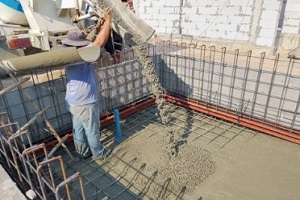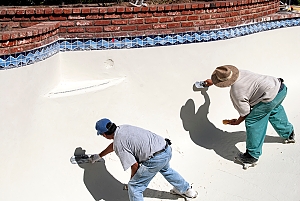 Installing a pool is an exciting time, and most families are eager to start swimming as soon as the contractors leave. Pool installation is a carefully curated process, and swimming in a newly installed pool can permanently damage the structure if done too soon. In order to understand how long to leave a pool after installation, it’s helpful to first learn why pools need to sit undisturbed and what kinds of damage can happen if this process is cut short.
Installing a pool is an exciting time, and most families are eager to start swimming as soon as the contractors leave. Pool installation is a carefully curated process, and swimming in a newly installed pool can permanently damage the structure if done too soon. In order to understand how long to leave a pool after installation, it’s helpful to first learn why pools need to sit undisturbed and what kinds of damage can happen if this process is cut short.
Here’s how soon after a pool installation you can swim in it and why.
What Happens During Pool Installation
Pool installation is complex if done correctly. Everything from digging out the location for the pool to leveling the structure and connecting the plumbing and electrical components means that this job is best left to the professionals.
However, the biggest factor when it comes to swimming in a pool after installation is the plastering. Concrete pools are sealed and coated with plaster during the final step of construction. This ensures that they hold water and do not leak.
Once the plaster is applied, it will need to cure. The pool will be filled during this time, as plaster will cure underwater. However, if your family swims in the pool before the plaster cures fully, you can cause lasting damage that may mean a replastering project later on.
When You Can Swim After Installation
The plaster needs time to cure after installation before swimming starts. Follow the manufacturer’s instructions, but plan on at least five days of waiting. Ideally, the plaster should be allowed to cure for a full two weeks before the pool is brought into use.
While plaster does not truly cure completely for around ten months, families can enjoy their pool earlier than this! Knowing how much effort and expense went into crafting a beautiful new pool, it is worth the extra small wait to make sure that the plaster cures properly so that the pool lasts for as long as possible.
Damage Caused by Swimming Too Soon
For those who have a hard time waiting after pool installation, the temptation to jump into the inviting water is just too strong. However, swimming in a newly plastered pool can result in more than one significant problem. The most likely is damage to the plaster itself.
Whether getting in or out of the pool, swimming close to the sides or touching the bottom, a swimmer coming into contact with the plaster is almost guaranteed. If the plaster has not yet cured, this contact can change the shape of the plaster and contribute to leaks and improper sealing.
The swimmer is also at risk if they swim too close to plaster installation. The new plaster will be acid washed with muriatic acid after it has been installed, and even though much of this acid is washed away when the pool is filled, some of it remains. Muriatic acid exposure during these first few weeks of curing will change the pH of the water. Swimming in such water can cause severe eye irritation or even skin rashes.
Taking Care of the Plaster for Best Curing
While the plaster in a new pool cures, it must still be maintained in order to achieve the longest lasting results. This includes brushing the new plaster (gently) with a soft brush. Softly push any debris toward the drain at the bottom of the pool. This will ensure that algae and scaling do not inhibit the curing of the new plaster.
 During the first 72 hours, keep the pool’s filtration system active to remove the residues that come from new installation, including plaster dust and calcium hydroxide. Because the plaster and acid wash are contributing acidity to the pool water, the first week is also the time to adjust the water’s alkalinity daily. This is good practice for caring for a pool long-term, so be sure to test the water every day during this time to prevent damage from water that is too basic or too acidic.
During the first 72 hours, keep the pool’s filtration system active to remove the residues that come from new installation, including plaster dust and calcium hydroxide. Because the plaster and acid wash are contributing acidity to the pool water, the first week is also the time to adjust the water’s alkalinity daily. This is good practice for caring for a pool long-term, so be sure to test the water every day during this time to prevent damage from water that is too basic or too acidic.
If your pool is equipped with a heater, keep it off during the first few weeks of the curing process. The extra heat can warp the plaster and erode its watertight seal. A minimum of 28 days of curing is recommended before pool heaters are used.
Get Pool Installation Done Right the First Time
A pool can breathe new life into any home’s backyard, but it is important to make sure that installation is done correctly by experts who will provide a pool that lasts for many years. The professionals at Masten Pools have more than 35 years of experience installing concrete and vinyl pools the right way the first time. Contact us to learn more about installing a pool in you Maryland or Delaware home, whether you are considering concrete or vinyl.
